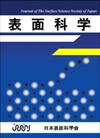巻号一覧

後続誌
33 巻, 7 号
選択された号の論文の9件中1~9を表示しています
- |<
- <
- 1
- >
- >|
巻頭言
-
福谷 克之2012 年 33 巻 7 号 p. 375
発行日: 2012/07/10
公開日: 2012/07/25
ジャーナル フリーPDF形式でダウンロード (193K)
第31回表面科学学術講演会特集号 [ I ]
-
姉崎 豊, 大谷 孝史, 須藤 晴紀, 加藤 孝弘, 加藤 有行, 末光 眞希, 成田 克, 中澤 日出樹, 安井 寛治原稿種別: 論文
2012 年 33 巻 7 号 p. 376-381
発行日: 2012/07/10
公開日: 2012/07/25
ジャーナル フリーGe(GeCx) and SiC(SiCGex) nanodots were formed on Si(001)2o off substrates after the formation of Si c(4×4) structure using monomethylgermane (MMGe). Surface structure of the Ge(GeCx) and SiC(SiCGex) nanodots was measured by scanning tunneling microscopy (STM). From the quantitative analysis of X-ray photoelectron spectroscopy (XPS), it was estimated that the Ge(GeCx) and SiC(SiCGex) nanodots existed in the ratio of about 1 : 2.4. SiC capping layer was formed on the Ge(GeCx), SiC(SiCGex) nanodots generated at 550∼650oC using monomethylsilane (MMSi). Photoluminescence (PL) spectra from the SiC/Ge (GeCx), SiC(SiCGex) dots/SiCx stacked structure were also measured. 抄録全体を表示PDF形式でダウンロード (968K)
抄録全体を表示PDF形式でダウンロード (968K) -
塩足 亮隼, 北口 雄也, 奥山 弘, 八田 振一郎, 有賀 哲也原稿種別: 論文
2012 年 33 巻 7 号 p. 382-387
発行日: 2012/07/11
公開日: 2012/07/25
ジャーナル フリーNitrogen monoxide (NO) has an unpaired electron in its 2π* orbital, giving rise to various reactivity such as dissociation and dimerization on the surfaces. One of the most important and frequently discussed issues has been whether its unpaired electron survives or not when adsorbed on metal surfaces; NO on metal surfaces is an ideal model system to study the interaction between molecular spin moment and condensed matters. We investigate the valence states of NO molecules adsorbed on Cu(110) with scanning tunneling microscopy (STM) and scanning tunneling spectroscopy (STS). Two orthogonal 2π* valence states are observed at the Fermi level, suggesting that the unpaired electron of NO is alive and localized on the molecule. The covalent interactions between two NO molecules are visualized by manipulating the overlap of their “active” 2π* orbitals. 抄録全体を表示PDF形式でダウンロード (1196K)
抄録全体を表示PDF形式でダウンロード (1196K) -
久保 利隆, 折田 秀夫, 野副 尚一原稿種別: 研究紹介
2012 年 33 巻 7 号 p. 388-393
発行日: 2012/07/10
公開日: 2012/07/25
ジャーナル フリーSurface structures of SrTiO3(001) have been studied by using scanning probe microscopy (SPM) and density functional theory (DFT) calculations. We observed several defective surface structures with true atomic resolution. It is found that all the defects are terminated by (001), (100) and (010) microfacets of TiO2 plane. We propose microfaceting TiO2 termination with Sr adatom models. The formation of the various types of defects is driven by the changes of the surface stoichiometry depending on surface preparations. 抄録全体を表示PDF形式でダウンロード (2581K)
抄録全体を表示PDF形式でダウンロード (2581K) -
伊藤 龍彦, 谷屋 啓太, 市橋 祐一, 西山 覚原稿種別: 研究紹介
2012 年 33 巻 7 号 p. 394-398
発行日: 2012/07/10
公開日: 2012/07/25
ジャーナル フリーWe propose H2-D2 titration method for evaluation surfaces of metallic catalysts, and have been applied to a study on the surface reconstruction of Pd foil model catalysts modified by the UHV treatment for H2-D2 exchange reaction. The UHV treatment brought about the reconstructed surfaces of Pd foil catalysts, and the improvement of H2-D2 exchangeactivity and the decrease of activation energy. The H2-D2 titration over the UHV-treated Pd foil catalysts indicated that the number of strongly adsorbed hydrogen atom species was increased by the UHV treatment. These results strongly suggest that the UHV treatment generates the newly active sites on Pd foil catalysts. The SEM study also supported the surface reconstruction of the Pd foil catalysts by the UHV treatment. In this report, we introduce the high sensitivity of the H2-D2 titration for hydrogen activation sites over a low surface area metallic catalyst. 抄録全体を表示PDF形式でダウンロード (587K)
抄録全体を表示PDF形式でダウンロード (587K) -
角山 寛規, 佃 達哉原稿種別: 研究紹介
2012 年 33 巻 7 号 p. 399-403
発行日: 2012/07/10
公開日: 2012/07/25
ジャーナル フリーThe article summarizes our recent advances on the size specific catalysis by polymer-stabilized gold clusters. We found that the smallest polymer-stabilized gold clusters (diameter = 1.3 nm) exhibit excellent activity for oxidation of alcohol, H2O2 generation from ammonium formate and molecular oxygen, and hydroxylation of dibenzylketones, by utilizing a molecular oxygen as an oxidant. The activity increases dramatically with decreasing the size down to 1 nm, which is closely correlate electronic structure of the smallest gold clusters. Various spectroscopic characterizations revealed that the smallest, active gold clusters are negatively charged through electron transfer from surrounding polymers, and as a result adsorbed molecular oxygen can be activated for the oxidation reaction through transfer of the excess electrons from the gold clusters, which are located in the high lying LUMO level of gold in the case of the smallest clusters. 抄録全体を表示PDF形式でダウンロード (1629K)
抄録全体を表示PDF形式でダウンロード (1629K)
総合報告
-
烏 彰孝, 本間 芳和原稿種別: 総合報告
2012 年 33 巻 7 号 p. 404-412
発行日: 2012/07/10
公開日: 2012/07/25
ジャーナル フリーWe reviewed the trends of carbon nanotube researches since the discovery of carbon nanotubes in 1991. In particular, we analyzed the progress of applications of carbon nanotubes to devices and device materials. Applied researches emerged around 2000 after fundamental properties were studied and synthesis methods were developed. Since then, carbon nanotubes have been applied to a wide variety of devices and used as functional materials in various fields. 抄録全体を表示PDF形式でダウンロード (631K)
抄録全体を表示PDF形式でダウンロード (631K)
談話室
海外研究体験記
-
島田 透2012 年 33 巻 7 号 p. 413-414
発行日: 2012/07/10
公開日: 2012/07/25
ジャーナル フリーPDF形式でダウンロード (658K)
先端追跡
-
2012 年 33 巻 7 号 p. 415
発行日: 2012/07/10
公開日: 2012/07/25
ジャーナル フリーPDF形式でダウンロード (191K)
- |<
- <
- 1
- >
- >|